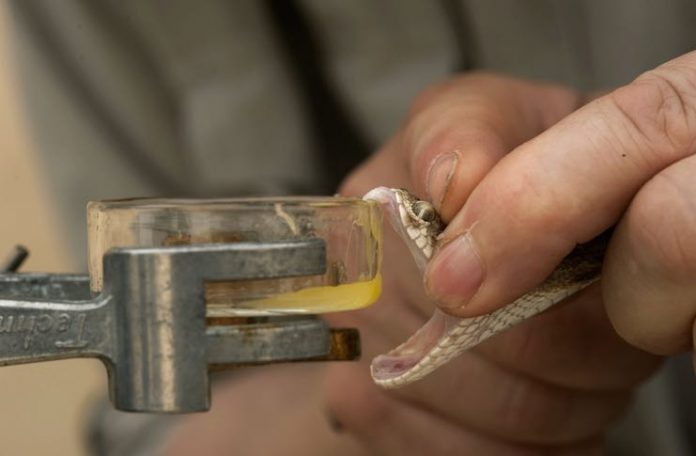Snake venom is the poisonous fluid usually yellow in colour located in the salivary glands of venomous snakes. The world is littered with poisonous snakes. Of the 3400 species of snakes, at least 600 species are venomous.
Deadly snakes use their venom to immobilise their prey for feeding purposes. They also use it as a defense mechanism against predators. Despite the deadly properties of snake venom, it has been used to develop drugs used to treat a wide range of conditions including erectile disfunction.
The Composition of Snake Venom
Venom is composed of molecular substances such as proteins and enzymes which work to disrupt nerve impulses and destroy cells. Proteins are toxic and are responsible for most of the deadly effects of snake venom.
The enzymes aid in the quickening of chemical reactions which are responsible for breaking chemical bonds between large molecules. Enzymes help to break down the following in the bite victims:
- Carbohydrates
- Proteins
- Phospholipids
- Nucleotides
Polypeptide toxin is an additional component of snake venom. This amino acid disrupts cell functions causing cells to die.
Different venomous snake species may contain similar toxic components. However, there are components which are only found in specific species.
Snakes use their venom sparingly only releasing enough to immobilise prey or defend themselves against predators.
Effects of Snake Venom on Prey
Once the venom is released into the body of prey or foe, it works by breaking down tissues and cells. This may have the following effects on the snake bite victim:
- Paralysis
- Lower blood pressure
- Destruction of red blood cells
- Internal bleeding
- Interfere with muscle control
- Death
In order for it to be effective, it must get into tissues so that it can find its way into the bloodstream.
Interestingly, snake venom components are used to develop drugs to treat human diseases.
Types of Snake Venom
There are three main types of snake venom:
- Cytotoxins,
- Neurotoxins,
- Hemotoxins
Other types of toxins are cardiotoxin, mycotoxins and nephrotoxins. They affect specific types of cells.
- Cytotoxins
These ones destroy body cells and cause most or all the cells in an organ or tissue to die. This condition is known as necrosis. Some of the tissues may be partially dead in a condition known as liquefactive neurosis.
Cytotoxins aid in partially digesting the prey before the snake feeds on it. These toxins are specific to the cells they attack, for instance:
- Cardiotoxins damage heart cells
- Nephrotoxins go for kidney cells
A large number of venomous snakes have a combination of cytotoxins.
- Neurotoxins
Neurotoxins make a beeline for the nervous system. They disrupt neurotransmitters that are sent between neurons. They may block voltage-gated calcium and potassium channels which are important passing signals along neurons.
Neurotoxins cause paralysis mainly resulting in respiratory complications and even death.
- Hemotoxins
These toxins affect normal blood coagulation processes. They cause red blood cells to burst open by:
- Inhibiting blood clotting factors
- Cause tissue death
- Causing organ damage
When red blood cells are destroyed and the clotting factor is interfered with, internal bleeding is the end result. Too many dead red blood cells can inhibit proper kidney function.
Some hemotoxins cause platelets and other blood cells to be lumped together causing clots which block circulation through vessels. This can lead to heart failure.
Types of Snakes and their Venom Injection System
Snakes are classified into three main families.
Viperidae
They have a well-developed injection system. The venom in these snakes is produced and stored in glands. Vipers erect their front fangs before digging them into their prey and release them once the poison has been injected. Once the poison has immobilized the prey, the viper has its dinner.
Elapidae
Mambas, cobras and adders belong to this family. Their delivery system is similar to that of the vipers. The difference is elapids do not have mobile front fangs with the exception of the death adder. Most of them have short small fangs that are eternally fixed and erect.
Once they bite their prey, they maintain their grip and chew to drive in the venom to the maximum.
Colubridae
They have one open canal on each fang which passes venom from the snake to its victim. They have fangs in the rear which are fixed. They chew their prey while the venom seeps in. Their venom is not as deadly as the other two classes. However, the twig snake and boomslang are the exceptions here.
Health Benefits of Snake Venom
The venom of the Brazilian pit viper is used to make drugs used in the treatment of hypertension. The venom extracted from rattlesnake and saw-scaled viper has been used to treat heart conditions such as angina.
Hemotoxins have been used to develop drugs for the treatment of high blood pressure, heart attack and blood disorders. This is because hemotoxins have anti-clotting properties. Neurotoxins are used in the development of drugs to treat stroke and brain-related diseases.
Other conditions that may be treated using snake venom include Alzheimer’s disease, cancer, heart disorders and erectile dysfunction for which cobra venom is renowned.
Conclusion
Extracting venom from these deadly serpents is a grueling exercise that requires intense preparation and execution. However, the discoveries made that have impacted positively on health are insurmountable.



